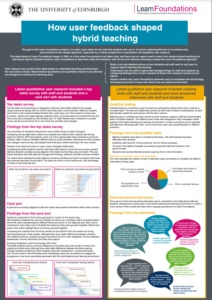The research described in our poster was carried out as part of the Learn Foundations project, which aims to provide staff and students with the best possible user experience of Learn. Key aspects of the Learn Foundations vision are to make courses in Learn accessible to all, to ensure students can easily find relevant information and to ensure staff find Learn easy to use and are well supported to make and deliver rich courses online.
Since the project began in 2018 it has successfully engaged with staff and students across the University. Project activities have included training events for staff, the creation of a glossary to support consistent use of terminology, and the development of the Learn Foundations template – a tool to help ensure courses are structured uniformly. Learn Foundations follows a service design approach, where a sound understanding of perspectives of both the service users and operators leads to a well-functioning, sustainable service. Achieving this understanding relies on a comprehensive programme of user research, which has always been an important part of Learn Foundations. In early phases of the project, (pre-Covid-19) a mix of quantitative and qualitative research methods were used to collect data about staff and students’ use of Learn.
Findings from this research were used to inform key elements of the project like the development of the glossary and the courses template. The latest phase of Learn Foundations began in 2020 when the University was adapting to the new hybrid teaching and learning environment brought about by the pandemic. An increased number of Schools had opted to adopt the Learn Foundations approach to help them make the transition to hybrid. Research was essential at to understand how hybrid teaching and learning was taking place across the University and how Learn, central to the new hybrid context, was being used by staff and students to complete teaching and learning tasks. It was also important to understand how the Learn Foundations approach was supporting the transition, and whether elements developed pre-Covid-19, like the glossary and templates, were still valid in the new context.
To address the research aims in this latest phase, a programme of quantitative and qualitative methods was designed. Since a fundamental aim was to contrast the hybrid context with pre-hybrid, it was logical to choose methods which had been used previously, to allow precise comparisons to be made. The top tasks survey was a tried-and-tested method of understanding staff and student priorities within Learn. The card sort activity (carried out with students) had also been used in previous phases of Learn Foundations to reveal how students’ preferences around finding key items within Learn. To expand on the quantitative data gathered in these two studies, usability tests and semi-structured interviews with staff and students were completed. The quantitative and qualitative research and analysis was carried out by Ed Lithgow, Paul Smyth and Alan Hamilton and other members of the Educational Design and Engagement team, guided and supported by Emma Horrell from the User Experience and Digital Consultancy team. Data obtained from the latest research were compared to data from earlier phases of the project to answer questions about what had changed in the shift to hybrid. These findings are presented in the poster, the accompanying video, and in a series of blog posts published on the Website and Communications blog.
More information about the project and its activities is available on the Learn Foundations website. (https://www.ed.ac.uk/information-services/learning-technology/virtual-environments/learn/about-learn/learn-foundations) You can read more about the Learn Foundations user research and findings from this phase and earlier phases of the project on the Website and Communications blogs about Learn Foundations. (https://blogs.ed.ac.uk/website-communications/tag/learn-foundations/)

